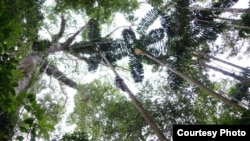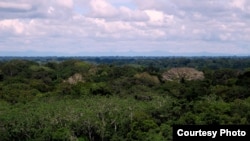Hidden in the canopy of the tropical rainforest is the secret to its evolution. The tale embedded in the chemistry of each leaf relates to how the tree adapts to pests, pathogens, and changes in environment and climate. A new study in the journal of the National Academy of Sciences finds that understanding the traits found in these interlocking branches and leaves at the top of the trees can help better manage and protect these forests, which are disappearing at an alarming rate.
Climbers scale 3,560 trees
Lead author and Carnegie Institution ecologist Greg Asner based his findings on an expedition to gather foliage from the top of 3,560 trees across 19 forests in the western Amazon. He says when you look down on the region from an aircraft, it resembles a green carpet “and is pretty monotonous…Our question was, is it really that monotonous? Is it all the same? Or is it really variable in terms of how it functions and how it has been put together evolutionarily?”
To find the answer, Asner deployed climbers up the 45-meter trees to the canopy, the central nervous system of the forest that regulates water flow, stores carbon and provides habitat. “The Western Amazon is now understood to be... if not the, then one of the highest biodiversity regions on the planet. More species per acre exist there than nearly anywhere else. And also it’s an area that’s rapidly changing with land development and with climate change.”
Different traits in neighboring trees
In his canopy analysis, Asner describes the forest as a rich mosaic that varies with elevation and soil content. “What we found is that the species that are found on these different [areas] have radically different chemistries as communities of trees. So a community on this [area], if you can walk just a few miles away to a new [area], it’s a different chemical makeup in the next canopy.”
What came as a complete surprise was that neighboring trees in the same community had distinct chemical signatures, says Asner. “Every time you climb a tree you’re basically getting a completely different chemical portfolio from the last tree that you climbed. In other words, there is an enormous diversification of chemical traits among the different trees that are living together. We thought that the variation would be slower across the Amazon basin, but what we see is that almost every tree has evolved its own chemical traits unique from one another."
Tree chemistry can help protect forests
Asner explains that how those trees evolved traits to combat pests and pathogens and or to survive environmental change can help predict how the species will respond to future threats, such as land use, drought or climate change. He hopes better forest management can emerge based on the findings. “And what do we have to do to do that? What kinds of protected areas do we set up? What kinds of management treatments do we make sure are in place in terms of human use of the forest and so forth? A lot of that can be predicted by understanding the chemistry of trees.”
Asner's study is the scientific debut for the Spectranomics Project, a field and laboratory-based effort to study tropical forests. The project plans to release a series of reports on biological hot spots including forests in Madagascar, Ecuador and Australia.
Climbers scale 3,560 trees
Lead author and Carnegie Institution ecologist Greg Asner based his findings on an expedition to gather foliage from the top of 3,560 trees across 19 forests in the western Amazon. He says when you look down on the region from an aircraft, it resembles a green carpet “and is pretty monotonous…Our question was, is it really that monotonous? Is it all the same? Or is it really variable in terms of how it functions and how it has been put together evolutionarily?”
To find the answer, Asner deployed climbers up the 45-meter trees to the canopy, the central nervous system of the forest that regulates water flow, stores carbon and provides habitat. “The Western Amazon is now understood to be... if not the, then one of the highest biodiversity regions on the planet. More species per acre exist there than nearly anywhere else. And also it’s an area that’s rapidly changing with land development and with climate change.”
Different traits in neighboring trees
In his canopy analysis, Asner describes the forest as a rich mosaic that varies with elevation and soil content. “What we found is that the species that are found on these different [areas] have radically different chemistries as communities of trees. So a community on this [area], if you can walk just a few miles away to a new [area], it’s a different chemical makeup in the next canopy.”
What came as a complete surprise was that neighboring trees in the same community had distinct chemical signatures, says Asner. “Every time you climb a tree you’re basically getting a completely different chemical portfolio from the last tree that you climbed. In other words, there is an enormous diversification of chemical traits among the different trees that are living together. We thought that the variation would be slower across the Amazon basin, but what we see is that almost every tree has evolved its own chemical traits unique from one another."
Tree chemistry can help protect forests
Asner explains that how those trees evolved traits to combat pests and pathogens and or to survive environmental change can help predict how the species will respond to future threats, such as land use, drought or climate change. He hopes better forest management can emerge based on the findings. “And what do we have to do to do that? What kinds of protected areas do we set up? What kinds of management treatments do we make sure are in place in terms of human use of the forest and so forth? A lot of that can be predicted by understanding the chemistry of trees.”
Asner's study is the scientific debut for the Spectranomics Project, a field and laboratory-based effort to study tropical forests. The project plans to release a series of reports on biological hot spots including forests in Madagascar, Ecuador and Australia.






